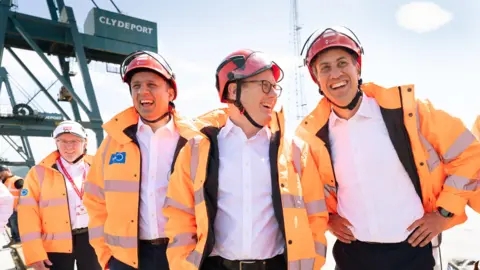Six takeaways from Keir Starmer’s ‘plan for change’

 pa media
pa mediaSir Keir Starmer has set out his “plan for change” – six “milestones” he wants voters to measure against his government at the next election.
Here are six key points from the PM’s speech and the quiz that followed.
What are the milestones?
All milestones are to be met by the next general election, possibly in 2029 – and in the case of clean energy, to be “on track” for the 2030 deadline.
The targets on homebuilding, NHS waiting lists and school-readiness apply only to England.
Recruiting more police is for England and Wales, while clean electricity and increasing household incomes are UK-wide.
they are:
- Putting more money in the pockets of working people
- Construction of 1.5 million houses and fast-tracking planning decisions on at least 150 major infrastructure projects
- Treating 92 per cent of NHS patients within 18 weeks
- Recruiting over 13,000 police officers, special constables and PCSOs into neighborhood roles
- Ensuring that three-quarters of five-year-olds are school ready
- 95% clean electricity by 2030
Not to be confused with mission, foundation and first steps…
When Sir Keir talks about what his government wants to do it is easy to get confused.
As we understand it, the six “milestones” set today are the things on which voters will want to evaluate the government by 2029, when the next election is likely to be held.
They follow six “first steps” set out by him in May, just before a general election was called.
The six milestones are ways to measure five missions He leaves in February 2023.
The mission – such as building an NHS fit for the future – is the driving purpose for the government. Civil servants have been ordered to give them priority.
According to Sir Keir, it is all built on three foundations – economic stability, secure borders and national security.
95% clean electricity by 2030
 pa media
pa mediaThe Prime Minister said being “on track” to have 95% clean electricity by 2030 was one of his milestones.
But before and during the election, Labor constantly talked about “zero carbon electricity by 2030” – and this was what was promised in the party’s manifesto.
Sir Keir denied that he was moving back to 100% zero carbon, telling reporters that “the clean energy pledge today is exactly the same as it was at the election” and “there is always going to be a mix (of energy sources). Was”.
Is he right?
The 95% clean electricity figure follows advice from the National Energy System Operator (NESO), which recently said that a clean electricity system is one where demand is “met primarily by renewable energy, supplied Gas-fired generation is rarely used to ensure safety”.
It states that gas should “provide less than 5% of Great Britain’s generation in a typical weather year”.
Two years ago Sir Keir also acknowledged that fossil fuels may need to be “comeback”.
So while 95% clean power has seemed to be in line with official advice and concessions in the past, this is the first time this figure has been used by the Prime Minister.
Warning for ‘lazy’ civil servants
The most special thing about the Prime Minister’s speech was that most of it was shocking to the civil service.
Many people in Whitehall, he said, were “comfortable in the lukewarm bath of managed decline”.
Amid considerable frustration at the top of his administration over his ability to bring about change, the Prime Minister said that “mission-led government” was not just about providing transformed public services, but about changing the nature of government. Was also.
He said he would not apologize for fixing it.
“Make no mistake, this plan will land on the desks in Whitehall with a huge challenge.”
Migration goal is not a milestone
There was no mention of immigration among the Prime Minister’s achievements and he was repeatedly pressed by journalists on this issue.
He said both legal and illegal migration would be controlled with “a serious plan”, including measures to “dismantle the gangs running the despicable (small boats) trade”.
However, migration was not one of his milestones, he said, because reducing it was “one of the basic things the government should do”.
When asked why he was not giving any figures to the public to measure performance on this, he replied that he was not going to put any “arbitrary number” on this.
Feeling better (or not)
Labor has not dropped its commitment for the UK to have the highest sustained growth in the G7 – despite speculation it is being quietly abandoned.
But Sir Keir now wants to talk about it in a way that he thinks will mean something to the average voter.
He believes the main test in the next election is whether voters feel better.
Its measure will be called “real household disposable income” (RHDI).
But they have not set a target for how much it should increase, leading some to believe it is meaningless.
The independent Office for Budget Responsibility has already predicted that the RHDI will increase by an average of 0.5% per year in this Parliament, for a total of 3.5%.
Sir Keir ignored questions from journalists and insisted living standards had fallen under the Conservatives – and people know when they are better off.
This was tested in the July general election, he said, with people coming to his door across the country telling him they were feeling worse.
But during the 2019-2024 Conservative government, real household disposable income technically increased by an average of 0.3%.






